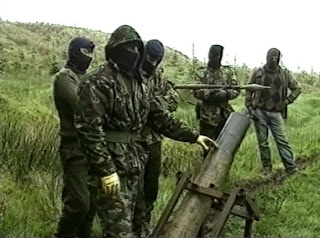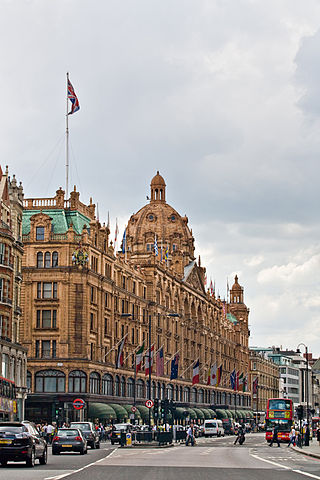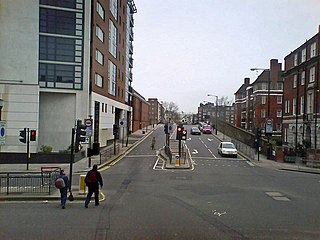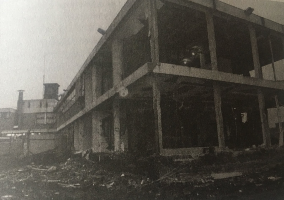Related Research Articles
The Real Irish Republican Army, or Real IRA (RIRA), was a dissident Irish republican paramilitary group that aimed to bring about a United Ireland. It was formed in 1997 following a split in the Provisional IRA by dissident members, who rejected the IRA's ceasefire that year. Like the Provisional IRA before it, the Real IRA saw itself as the only rightful successor to the original Irish Republican Army and styled itself as simply "the Irish Republican Army" in English or Óglaigh na hÉireann in Irish. It was an illegal organisation in the Republic of Ireland and designated a proscribed terrorist organisation in the United Kingdom and the United States.

The East Tyrone Brigade of the Provisional Irish Republican Army (IRA), also known as the Tyrone/Monaghan Brigade was one of the most active republican paramilitary groups in Northern Ireland during "the Troubles". It is believed to have drawn its membership from across the eastern side of County Tyrone as well as north County Monaghan and south County Londonderry.

From 1969 until 1997, the Provisional Irish Republican Army (IRA) conducted an armed paramilitary campaign primarily in Northern Ireland and England, aimed at ending British rule in Northern Ireland in order to create a united Ireland.

The Harrods bombing refers to the car bomb that exploded outside Harrods department store in central London, England, on Saturday 17 December 1983. Members of the Provisional Irish Republican Army planted the time bomb and sent a warning 37 minutes before it exploded, but the area was not evacuated. The blast killed three police officers and three civilians, injured 90 people, and caused much damage. The IRA Army Council said it had not authorised the attack and expressed regret for the civilian casualties. After the bombing, the IRA shifted its emphasis towards attacks on military targets in England.
On 28 February 1985, the Provisional Irish Republican Army (IRA) launched a heavy mortar attack on the Royal Ulster Constabulary (RUC) base at Corry Square in Newry, County Down, Northern Ireland. The attack killed nine RUC officers and injured almost 40 others; the highest death toll ever suffered by the RUC. Afterwards, a major building scheme was begun to give police and military bases better protection from such attacks.
The Ballygawley bus bombing was a roadside bomb attack by the Provisional Irish Republican Army (IRA) on a bus carrying British soldiers in Northern Ireland. It occurred in the early hours of 20 August 1988 in the townland of Curr near Ballygawley, County Tyrone. The attack killed eight soldiers and wounded 28. In the wake of the bombing, the British Army began ferrying its troops in and out of County Tyrone by helicopter.
This is a chronology of activities by the Provisional Irish Republican Army (IRA) from 1980 to 1989. For actions before and after this period see Chronology of Provisional Irish Republican Army actions.

On the evening of 26 March 1997, the Provisional Irish Republican Army (IRA) East Tyrone Brigade launched an improvised grenade attack on the fortified Royal Ulster Constabulary/British Army base in Coalisland, County Tyrone, Northern Ireland. The blast sparked an immediate reaction by an undercover Special Air Service unit, who shot and wounded Gareth Doris, an Irish republican and alleged IRA volunteer. The SAS unit was then surrounded by a crowd of protesters who prevented them approaching Doris or leaving. RUC officers arrived and fired plastic bullets at the crowd, allowing the special forces to leave the area.
The Thiepval Barracks bombing was a double car bomb attack carried out by the Provisional Irish Republican Army (IRA) on 7 October 1996. The bombs exploded inside Thiepval Barracks, the British Army headquarters in Northern Ireland. One British soldier was killed and 31 people were injured. This bombing was the first major attack on a military base in Northern Ireland since the end of the IRA's ceasefire eight months earlier.

On 15 June 1988 an unmarked military van carrying six British Army soldiers was blown up by the Provisional Irish Republican Army (IRA) at Market Place in Lisburn, Northern Ireland. The explosion took place at the end of a charity marathon run in which the soldiers had participated. All six soldiers were killed in the attack – four outright, one on his way to hospital and another later on in hospital.

Ebrington Barracks was a military installation on the east bank of the River Foyle in Derry, Northern Ireland.
The 1987 Rheindahlen bombing was a car bomb attack on 23 March 1987 at JHQ Rheindahlen military barracks, the British Army headquarters in West Germany, injuring thirty-one. The large 300 lb (140 kg) car bomb exploded near the visitors officers' mess of the barracks. The Provisional IRA later stated it had carried out the bombing. It was the second bombing in Rheindahlen, the first being in 1973, and the start of the IRA's campaign on mainland Europe from the late 1980s to the early 1990s. Although British soldiers were targeted, most of the injured were actually German officers and their wives.
The Provisional IRA carried out two separate attacks on the same day on 1 May 1988 against British military personnel in the Netherlands which resulted in the deaths of three RAF members and another three being injured. It was the worst attack suffered by the British security forces during The Troubles from 1969 to 1998 in mainland Europe.

The Lichfield gun attack was an ambush carried out by the Provisional IRA (IRA) on 1 June 1990 against three off-duty British soldiers who were waiting at Lichfield City railway station in Staffordshire. The attack resulted in one soldier being killed and two others badly wounded.

The Chelsea Barracks bombing was an attack carried out by a London-based Active Service Unit (ASU) of the Provisional IRA on 10 October 1981, using a remote-controlled nail bomb. The bomb targeted a bus carrying British Army soldiers just outside Chelsea Barracks. The blast killed two civilians and injured 40 people, among them 23 soldiers.
This is a timeline of the events and actions during the Troubles that were carried out in Great Britain, the vast majority of which were carried out by Irish Republican paramilitaries mainly the Provisional IRA were by far the most active but both the Official IRA and the Irish National Liberation Army, also carried out a number of attacks, which included bombings and shootings. Ulster Loyalist paramilitary groups also carried out a small number of violent actions.
The Provisional IRA (IRA) planted a bomb underneath a minibus at an army recruiting centre in Wembley, northwest London on 16 May 1990, killing a soldier and injuring four others. The dead victim was the van's driver, 34-year-old Sergeant Charles Chapman from the Queen's Regiment, a father of two. The injured included his colleague, who got shrapnel wounds to his legs and right shoulder, and a burned face. The bomb was believed to have been 2 lb (910 g) of Semtex and shattered nearby windows when it exploded around 5:15 pm. The van was an unmarked white Leyland Sherpa parked in an alleyway behind the office, which was checked by the two soldiers beforehand but the bomb was cleverly hidden, and detonated as Chapman turned on the ignition. The bomb could have caused more casualties had it exploded later when the van entered the busy street.

On 2 November 1991, a bomb planted by the Provisional IRA exploded in the Military Wing at Musgrave Park Hospital, Belfast. Two British soldiers were killed and nine others were wounded. Two children, a five-year-old girl and a baby of four months, were also injured by the blast.
This is a timeline of the events and actions during the Troubles that were carried out in Western Europe, the countries included are West Germany, Belgium & the Netherlands the vast majority of which were carried out by Provisional IRA (PIRA) the other Irish Republican group was the Irish National Liberation Army (INLA) who carried out a small few attacks more for propaganda purposes. According to a study 18 people were killed on mainland Europe during The Troubles with around 60 people being injured.
References
- ↑ Alan Cowell. "British barracks struck in bombing". The New York Times .
- ↑ "Bombs Rip British Barracks in Germany; 9 Hurt". LA Times. Associated Press. 13 July 1988.
- ↑ Lawlor, Éamonn. "IRA Bomb British Base BROADCAST: 1988.JUL.13". RTE Archives Collections. RTE. Retrieved 14 June 2022.
- ↑ Ap (6 August 1988). "British Barracks Bombed in West Germany". The New York Times. ISSN 0362-4331 . Retrieved 30 January 2020.